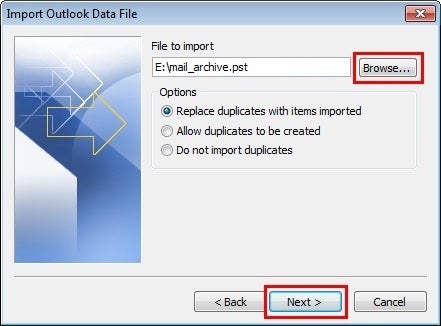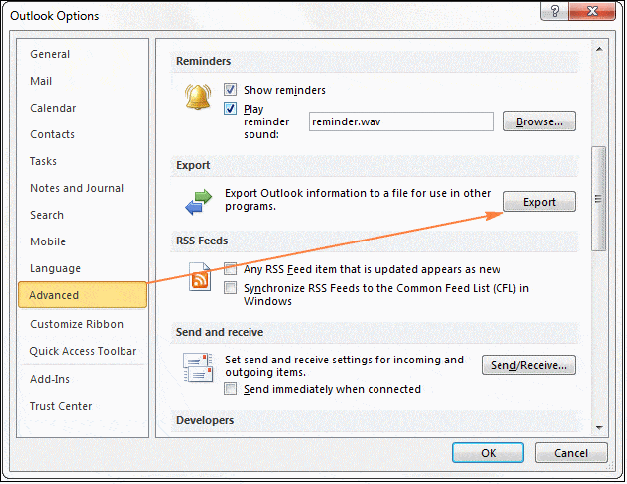
In the Folder Pane, you might see a folder named Recovered Personal Folders that contains your default Outlook folders or a Lost and Found folder. What happens after you repair an Outlook Data File? When the repair is complete, start Outlook with the profile associated with the Outlook Data File you just repaired. In some cases, items may not be recovered if they were permanently deleted or corrupted beyond repair. You may need to run the tool several times in order to repair your Outlook Data File. To change the default name or location of this backup file, in the Enter name of backup file box, enter a new name, or choose Browse to select the file you want to use. Note: The scan creates a backup file during the repair process. If you need help locating your Outlook Data File, see Locating the Outlook Data Files. Select Browse to select the Outlook Data File (.pst) you want to scan. Outlook 2007: C:\Program Files (x86)\Microsoft Office\Office12 Outlook 2010: C:\Program Files (x86)\Microsoft Office\Office14 Outlook 2013: C:\Program Files (x86)\Microsoft Office\Office15 Outlook 2016: C:\Program Files (x86)\Microsoft Office\root\Office16 Outlook 2019: C:\Program Files (x86)\Microsoft Office\root\Office16
#HOW TO MAKE OUTLOOK 2016 OPEN PST FILE HOW TO#
For more information, see How to back up an Outlook data file.Įxit Outlook and browse to one of the following file locations: We recommend backing up your existing Outlook data file before you start the Inbox Repair tool. If you can't start the Inbox Repair tool, you should try to repair your Outlook program. The tool only looks for errors (corruption), and if there are any, gives you the opportunity to allow the tool to fix those errors. Please like and share this guide to help others.The Inbox Repair tool doesn't connect or analyze any data stored in an Exchange mailbox. That it! Let me know if this guide has helped you by leaving your comment about your experience. Select Outlook Data File (.pst) & click Next. File > Open & Export > Outlook Data File.

Select the old Outlook PST file that you want to import & click Open. Select the Personal Folder File (.pst) & click Next. Select Import from Another Program or File & click Next. If you want to import an existing Outlook PST file in the new profile, then, from Outlook's main menu, select: How to Import an existing PST file in Outlook. If you upgraded to Outlook 2016, 2013 or 2010, on a computer that already had data files created in previous versions of Outlook (2007 or 2003), then the. In Outlook 2016, Outlook 2013 & Outlook 2010 versions, the Outlook Data file is stored by default at the following location:Ĭ:\Users\%Username%\Documents\Outlook Files\.pstĢ. * Additional Info: By default, when you create a new Outlook profile or when you launch Outlook 2007 or 2003, for first time, the Outlook stores its data file (.pst), at the following location on the disk:Ĭ:\Users\\AppData\Local\Microsoft\Outlook\Outlook.pstĬ:\Documents and Settings\\Local Settings\Application Data\Microsoft\Outlook\Outlook.pstġ. from your old computer) into the new profile. How to Import your old Outlook PST Data (E-mails, Contacts, Tasks, etc.) to Outlook.Īfter you have created the new Outlook profile, you can simply launch Outlook and start using the new profile immediately* or you can import an existing Outlook data file (e.g.

Leave the Always use this profile option if this will be the only Outlook profile. Check the Prompt for a profile to be used option, if this is a secondary Outlook profile, orħb. Proceed to setup your new email account, or, click Cancel (and then OK) to create your profile without adding an e-mail account at this time.ħa. Click the Add button and type a profile name (e.g.
#HOW TO MAKE OUTLOOK 2016 OPEN PST FILE WINDOWS 10#
Windows 10 & 8: Right click at the Start Menu and choose Control Panel.ĥ.Windows 7, Vista: Click the Start menu and select Control Panel.How to Create a New Outlook Profile and Import Outlook PST file. PST file from your old PC) to the newly created Outlook profile. This tutorial will guide you through the steps needed to create a new Outlook Profile (primary or secondary) in Outlook 2016, 2013, 2010, 20.Īt the second part of this tutorial you 'll learn how to import an existing Outlook personal folders data file (e.g. In several cases there is a need to create a new Outlook Profile, in order to resolve problems with the current Outlook profile or to specify a different personal store data file (.pst) for a specific Outlook Account.


 0 kommentar(er)
0 kommentar(er)
